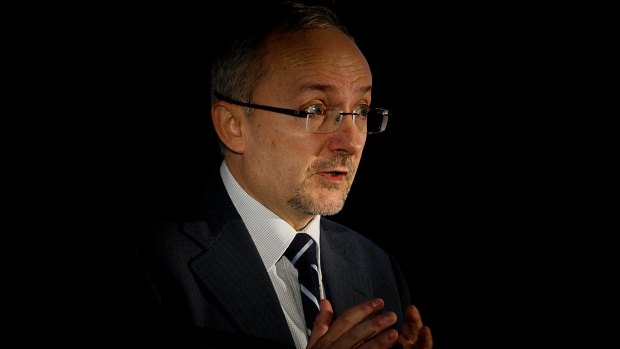This was published 5 years ago
The world is caught in a debt-trap built by central bankers
Could the current developed economy settings of low growth and low-to-negative real interest rates reflect a catch-22 interaction where the low rate environment established by the key central banks perpetuates low rates and low growth?
That’s a question effectively posed, and answered tentatively in the affirmative, by a recent research paper issued by the Bank for International Settlements that builds on a thesis the BIS has been constructing in recent years that low rates beget lower rates, fuelling financial booms and busts and too much debt and too little growth.

Dr Claudio Borio, head of the BIS monetary and economic department.Credit: Jenny Evans
In what is a highly technical paper, BIS researchers, led by the head of its monetary and economic department, Claudio Borio, argue that monetary policies play a more important role than commonly thought in long-run economic outcomes.
In the post-crisis period, much of the debate within central banks about the inability of low, or even negative, real interest rates to generate meaningful economic growth has revolved around structural changes in developed world economies.
Indeed, the Reserve Bank of Australia discussed cutting interest rates from their record low 1.5 per cent at the board's meeting in April.
There has been considerable discussion about the "new normal,’’ or the way in which changes to the growth potential of developed economies generated by the impact of capital-light technologies, ageing demographics and rising savings rates has led to a slowdown in productivity growth, low inflation rates, meagre wages growth and weak economic growth.
That has led to a conclusion that the new "neutral rate,’’ or the level of rates that balances savings and investment and maximises employment and growth at relatively modest levels of inflation, is now much lower than it has been in the past.
The BIS paper adds another dimension to that discussions, arguing that current thinking might over-estimate the usefulness of the concept of a natural or neutral rate because that rate doesn’t include financial factors in its definition.
It argues that monetary policies play a major role in anchoring financial cycles and that the reactiveness of central banks influences those cycles, not least by influencing risk-taking.
In the post-financial crisis era, the key central banks deliberately drove down interest rates to historically unprecedented levels to encourage investors to take more risks in search of higher returns. That has led to a massive increase in leverage – debt to income and assets – at every level of the financial system.
Central banks have for decades debated inconclusively whether they should "lean’’ against financial asset bubbles by tightening monetary policy if they believed one was forming.
The BIS said the issue wasn’t so much whether monetary policy should "lean against the wind" but that "monetary policy is the wind.’’
As it says, monetary policy sets the price of leverage. By easing policy aggressively after a bubble bursts, central banks encourage risk-taking and higher leverage.
"If as a result debt continues to rise in relation to GDP, or does not adjust sufficiently, a ‘debt trap’ might emerge. It would become harder to raise interest rates without causing damage to the economy owing to the large debt over-hang.’’
Low rates encourage borrowing and this protracted post-crisis period of low rates will inevitably have expanded the universe of companies and individuals who can only survive – can only service their debts – if rates remain at ultra-low levels. That constrains the flexibility of the central banks.
In a debt trap, the contraction in demand could be interpreted as a sign that the natural rate had fallen, driven by deep underlying real factors.
Myopia could increase economic growth in the short term while encouraging risk-taking and financial bubbles in the longer term.
If, however, it were viewed through a lens that attached importance to monetary policy, financial cycles and indebtedness, it could be seen as a sign that the economy had been following an unsustainable path.
Essentially, the BIS paper argues that central banks need to incorporate the impacts of their own monetary policy on financial cycles into their thinking about neutral rates, perhaps including financial stability as an additional consideration in their mandates (it cites the Reserve Bank's mandate approvingly) and lengthening the horizon for their inflation objectives.
The BIS paper refers to the trade-offs in time horizons. Central banks tend to be responding to current and near-term conditions in real economies whereas financial cycles – booms and busts – can span a decade or more.
That myopia could increase economic growth in the short term while encouraging risk-taking and financial bubbles and ultimately lowering growth, perhaps abruptly and unpleasantly, in the longer term.
The rather large problem for central bankers, partly of their own making if the BIS analysis is correct, is that the developed world is already caught in the debt trap and the central banks that built the trap by keeping rates too low for too long to try to avoid recession, haven’t been able to inflate their way out of it.
Thus, while the BIS paper helps explain how the developed world arrived in the fragile, over-leveraged, low-growth and unproductive environment we’re still experiencing, and why the central banks are now bound within a straitjacket they designed, it doesn’t provide any pathways for an escape.